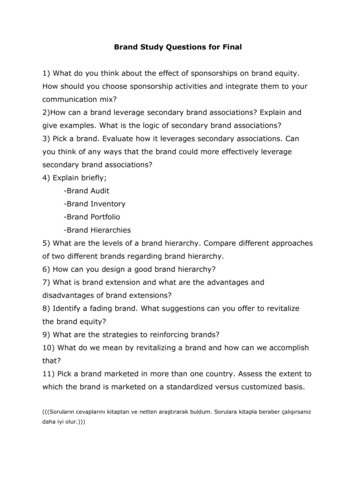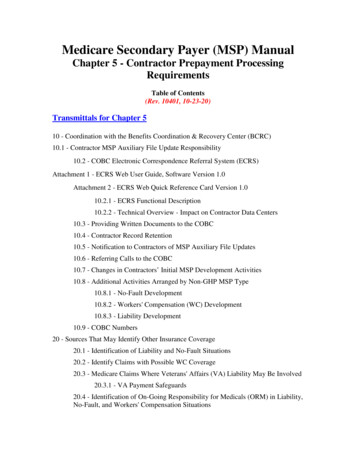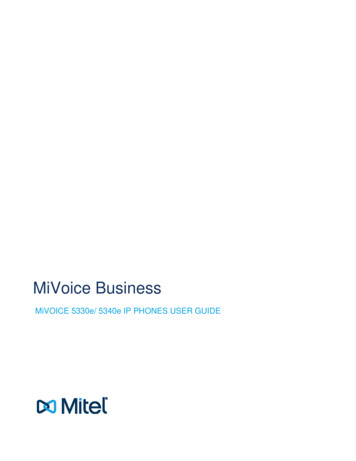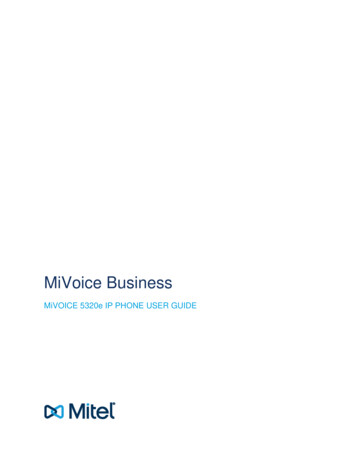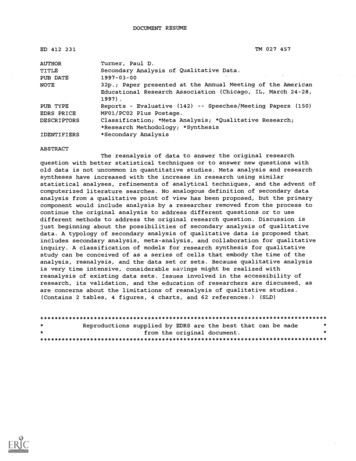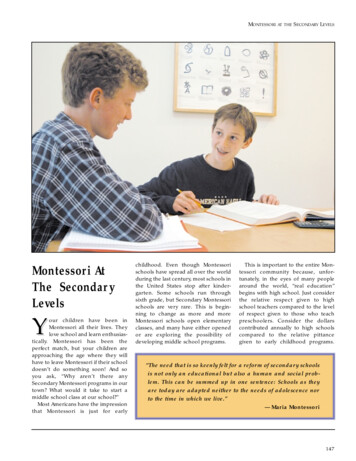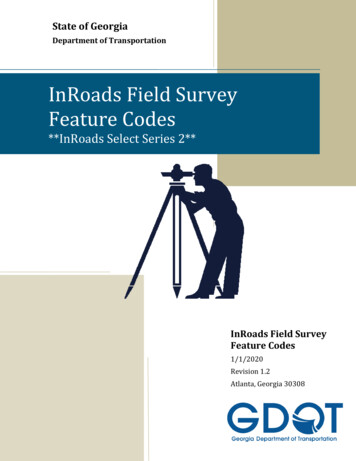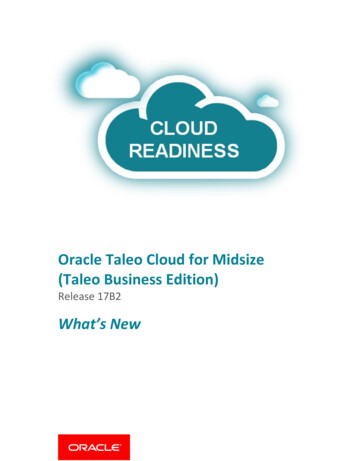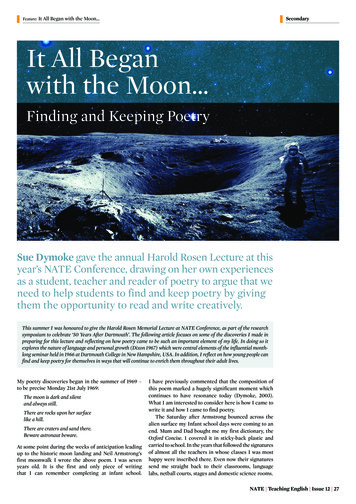
Transcription
SecondaryFeature: It All Began with the Moon It All Beganwith the Moon Finding and Keeping PoetrySue Dymoke gave the annual Harold Rosen Lecture at thisyear’s NATE Conference, drawing on her own experiencesas a student, teacher and reader of poetry to argue that weneed to help students to find and keep poetry by givingthem the opportunity to read and write creatively.This summer I was honoured to give the Harold Rosen Memorial Lecture at NATE Conference, as part of the researchsymposium to celebrate ‘50 Years After Dartmouth’. The following article focuses on some of the discoveries I made inpreparing for this lecture and reflecting on how poetry came to be such an important element of my life. In doing so itexplores the nature of language and personal growth (Dixon 1967) which were central elements of the influential monthlong seminar held in 1966 at Dartmouth College in New Hampshire, USA. In addition, I reflect on how young people canfind and keep poetry for themselves in ways that will continue to enrich them throughout their adult lives.My poetry discoveries began in the summer of 1969 –to be precise Monday 21st July 1969:The moon is dark and silentand always still.There are rocks upon her surfacelike a hill.There are craters and sand there.Beware astronaut beware.At some point during the weeks of anticipation leadingup to the historic moon landing and Neil Armstrong’sfirst moonwalk I wrote the above poem. I was sevenyears old. It is the first and only piece of writingthat I can remember completing at infant school.I have previously commented that the composition ofthis poem marked a hugely significant moment whichcontinues to have resonance today (Dymoke, 2003).What I am interested to consider here is how I came towrite it and how I came to find poetry.The Saturday after Armstrong bounced across thealien surface my Infant school days were coming to anend. Mum and Dad bought me my first dictionary, theOxford Concise. I covered it in sticky-back plastic andcarried to school. In the years that followed the signaturesof almost all the teachers in whose classes I was mosthappy were inscribed there. Even now their signaturessend me straight back to their classrooms, languagelabs, netball courts, stages and domestic science rooms.NATE Teaching English Issue 12 27
Feature: It All Began with the Moon “My infantschoolheadteacherstrived tocreate a schoolcommunity inwhich all wereencouragedto recogniseyoung people’screativepotential andachievements.”Sue Dymoke with RosemaryDavis, once her primary teacher,at the NATE Conference.Mrs Sharma was my reception class teacher. Herbrillant red and orange saris shimmered along thecorridor. She read us five-year-olds wonderful storiesand poems during wet playtimes. Miss Acker taught usitalic handwriting and thought that the curls of my ‘f’swere never ever neat enough. Mrs James was one of myjunior school teachers. Nature was what drove her. Shewas a huge exponent of the great outdoors as a stimulusfor writing. We were forever on field trips and naturewalks, sketching, jotting, peering through magnifyingclasses and binoculars. Thanks to her I experienced,at 8 years of age, the early morning beauty of a mistybluebell wood, learned to identify birdsong, beetles anddifferent varieties of wildflowers. Because of her I wroteand published poems in the school magazine. She madethe vital connection between nature and writing andforged an enticing path to for me to follow.For a long time I have tried to make sense of how andwhy I was taught in the particular way I was and whyI responded with such enthusiasm. As a result of theirteaching - not just their English teaching - I becameEdward Lear’s Runcible Spoon in our Junior school play(The Owl and the Pussy Cat went to Sea), listened in awe toUnder Milk Wood, savoured Portia’s unstrained ‘quality ofmercy’, enjoyed the language of algebra and quadraticequations, puzzled over T.S. Eliot’s mysterious voicesin ‘Journey of the Magi’ and always strove to perfect afast serve on the tennis court. But I want to concentrateon two teachers - one from Infant school and one fromsecondary school. Between them, they encapsulate somuch about my finding of poetry, my personal growththrough language.28 NATE Teaching English Issue 12‘The cupboard with its scarlet-ribboned key’:poetry at infant schoolThe first of these teachers was Rosemary Clayfield. Inthe late 1960s she was the newly appointed Headteacherof Letchmore Road Infants School in Stevenage, a fastexpanding ‘new town’ in the south east of England.She had arrived shortly after I had first started school.In later life she became Rosemary Davis, an emeritusProfessor at the Institute of Education, UniversityCollege, London.In Growth through English, John Dixon comments:It has taken the Infant Schools, in their work with fiveto-seven-year-olds, to prove that a new and complexrelationship is possible between the ‘skill’ elements andthe broader processes that prompt a child to use languagein the first place. (1967: 2)He also writes of the need for all pupils to explore thepower of language citing the example, from Holbrook’scontroversially titled English for the Rejected, of ‘Joan’, ayoung woman of low IQ, who wrote a poem about a littleyellow bird that ‘flew into the golden yellow sun’. Dixonnotes that such creative work gave educators a ‘newright to talk about the creative potentialities of all children’(1969: 27). Interestingly, Joan’s poem was drafted duringan examination. Given the Hirschian (1987) model ofknowledge acquisition that currently underpins publicexaminations endured by 16-year-olds in England, onewonders if such creative opportunities will ever beoffered again.It occurs to me now that at the same time theDartmouth Seminar was taking place in 1966, myinfant school headteacher was striving to create aninclusive school community in which pupils, parents,and teachers were all made to feel part of a sharedlearning conversation, in which all were encouragedto recognise young people’s creative potential andachievements. As I was talking to her for the very firsttime in over 40 years, Professor Davis noted that duringher own training (in London at Goldsmiths College andthe Laban Centre in the early fifties) she had learneda practical, activity-based approach to teaching thecurriculum in which art, drama and music were integralelements.Poetry featured very regularly in my infant schoollife. We heard poems in assemblies. We brought themalive through painting, dance and drama. We listenedto poems when rain speckled our classroom’s highwindows at playtime. We wrote poems. We longed toborrow poetry books from the ‘cupboard with its scarletribboned key’ (Dymoke, 1987: 6). We also read poems onthe ever-changing poetry noticeboard in the corridoroutside our Headteacher’s office – poems written byRossetti, Stevenson and Walter de la Mare, poems byother pupils, including my ‘moon’ poem. In readingthis poem with hindsight I can see the influence of dela Mare’s ‘Silver’ in terms of atmosphere, some aspectsof word choice and the feminisation of the moon as she‘walks the night in her silver shoon’ (de la Mare, 1958:106). However, in structure, rhyme scheme and voicemy piece is very different. My moon is an ominousplace, riven with risk, uncertainty and mystery for theastronauts. One could argue that the unknown silentsurface I describe mirrored the uncertain challenges ofthe blank page on which I was writing a poem for thefirst time.
Secondary‘To boldy go’: poetry as a legitimate actMy abiding memory of that poem is not the act of writingit – if only I could remember that! – but the way othersresponded to the piece – the life it would lead afterit had been written. I know that my class teacher, MrsBuckingham, liked it and showed it to her colleagues.I know that the headteacher pinned it to the poetrynoticeboard and that it seemed to stayed there for sometime. I also know that it was photocopied and possiblydisplayed somewhere outside school. All of those smallevents served as a vital and early affirmation that it wasokay for me to choose to write poetry. They signalledthat it was legitimate to explore an event beyond one’sown lived experience: a trip to the moon – somethingand somewhere that had been discussed, dreamedabout and imagined for the whole of that summer term.It was also okay to voice one’s fears about the dangersthat might lurk on the moon surface and to issue awarning to three astronauts whom I would never meetand who were highly unlikely to ever read my poem.Poetry gave me that freedom.Earlier this year, at Nottingham Playhouse, I listenedto the novelist Pat Barker talk about her writingprocesses. She urged writers in the audience to gointo writing ‘wanting to surprise yourself because ifyou can’t do that then no-one else will be surprised bywhat you write’. I love the element of risk implied byher approach. You are going out into the unknown inyour writing, exploring, as Star Trek’s Captain JamesT. Kirk would say, ‘strange new worlds new life andnew civilisations, to boldly go where no-one has gonebefore’. Children and adults who are learning to writecontinually need to experience this thrilling sense ofmission and discovery when they write. That’s what myschool experiences gave me. How often I wonder is itstill the case for young people in classrooms today?‘Our inner thought-foxes’: poetry atsecondary schoolThe second major influence on my journey to find andkeep poetry was Richard Wallace, an English teacher atThe Barclay School, a state secondary comprehensiveschool. He taught me when I was 11–13 and again forA Level. The activities he chose, his wealth of poeticknowledge and the quality of his written feedbackenabled me to learn how to develop my writing and todeepen my knowledge and understanding of poetry.This learning would, years later, feed directly into howI would go on to teach poetry in my own secondaryEnglish classrooms.With his wild wispy hair and flared checked trousersMr Wallace cut a gangly figure. To inspire us he blewbubbles in the classroom, set fire to things, made uscollect new cool words, write ballads and shape poems,haiku and even shorter pieces. Another student’s poem:Gone.She left me.was the piece I was most envious of. It stunned us allwith its economy.Through serious fun, our English teacher helpedus to find (after Ted Hughes) our own inner ‘thoughtfox(es)’ and experience the joy of how poetry canmake you think – an aspect of poetry teaching which isacknowledged as fundamental (Ofsted, 2007). Lookingback over the poetry he introduced us to I am amazed“Children and adults who are learning to writecontinually need to experience this thrillingsense of mission and discovery when theywrite. That’s what my school experiencesgave me. How often I wonder is it still thecase for young people in classrooms today?”at what we covered in the junior years of secondaryschool. It ranged from Beowulf to Elizabeth Jennings,Shakespeare to Roger McGough, Robert Browningto Stevie Smith. The connection between listening,reading and writing was ever present. Mr Wallace usedpoems as models for our writing but always gave uschoices and the freedom to use these as loosely as wewished. ‘My Bus Conductor’ by Roger McGough wasone such poem. It led me to write about my grandfatherwho worked on the railways his whole life until ‘thewhistle blew and the last station faded away’.‘Only connect’: poetry experiencesMr Wallace firmly believed in E.M. Forster’s instructionin Howard’s End (a novel partially set in my home town):‘only connect the prose and the passion and both willbe exalted’. He achieved this by creating a contextfor sharing poetry together, tapping into events inhis students’ own lives and creating new experiences.NATE Teaching English Issue 12 29
Feature: It All Began with the Moon “My teachersopened thedoor for meto a secondarydiscoursein that theyenabled meto find poetryfor myself, torecognise themarvellouseconomy,precision anddistillation oflanguage, togo on findingit beyond theclassroomand to keepit close in myhead and onthe page everafter.”The latter might involve seeing where Keats coughedup blood in Hampstead or by picking blackberries inthe scruffy bit of the school car park staining fingerswith Heaney’s ‘summer’s blood’.Mr Wallace was a huge fan of Thomas Hardy’swriting. I discovered his novels in our school librarywhen I was 12 and can still see the smile on my teacher’sface when I told him I had just borrowed Far from theMadding Crowd. Immediately he began to quote thenovel’s opening: ‘When Farmer Oak smiled the cornersof his mouth spread till they were within an unimportantdistance of his ears.’ However, it was to be Hardy’spoetry that had the greatest impression on me. Mostmemorable, was our group’s visit to Thomas Hardy’scottage in Higher Bockhampton, Dorset. Hardy’s poem‘The Self Unseeing’ always sends a shiver down myspine. Part of me is forever there in that cottage withour teacher standing in the doorway reading the poemand us, silently, waiting for the ‘dead feet’ to walk in.Richard Wallace completed his English degree andhis PGCE in London in the early 1970s with HaroldRosen as one of his examiners. He remembers littleabout these training experiences except that, like manyteachers of his generation, he learned a great deal ofpoetry in his undergraduate work and drew on thispoetry store in his teaching. This is so different frommany new teachers today who may have avoidedoptional poetry modules in their degrees and mayneed considerable subject knowledge support in theirPGCE year.Opening doors: access to secondary discoursesI come from a working class family. My parents bothleft school at the age of 14. Dad read us Winnie the Poohand Treasure Island at bedtime. Mum avoided reading(and writing) unless it involved deciphering knittingpatterns or recipes. Neither of them read poetry forBeryl Hales – The Writer’s Shed.30 NATE Teaching English Issue 12pleasure although Dad did chuckle over some overPooh’s hums and Mum could recite John Masefield’spoem ‘Cargoes’ from memory. Although not literarypeople, they knew the value of learning. They madesure I joined the library as soon as I was old enoughand I am eternally grateful for that. They indulged myrequests for a typewriter and books as birthday presents.One year I spent my book tokens on the beautifullyillustrated Louis Untermeyer’s Golden Treasury of Poetry(1969) which remains a favourite companion. Here Ifirst discovered May Swenson’s ravishing ‘Was Worm’with its dazzling compressed imagery:Was wormswaddled in white.Now, tiny sequin coatpeacock bright.
SecondaryThe day before I gave this lecture, I came across BerylHales’ writer’s shed miniature which was exhibitedin Sherwood Art Week in Nottingham. By coincidenceUntermeyer’s anthology was one of her favourite poetrybooks too and it forms the shed’s base. I am struck bythe significance of this: it seems to symbolise how readingpoetry underpins writing poetry.I went to three ordinary neighbourhood stateschools. Increasingly, however, I realise that my schoolexperiences were extraordinary. James Gee notes that‘if you have no access to the social practice, you don’t get inthe discourse, you don’t have it’ (2015: 168). The greaterthe distance that exists between one’s primary discourse– the discourse of home and family – and other,secondary, discourses, the greater the challenge therewill be to perform effectively within that new discourse.For some poets, like Seamus Heaney, poetry wasembedded within the home culture (Heaney, 1980).Not all young people are so fortunate. My teachersopened the door for me to a secondary discourse inthat they enabled me to find poetry for myself, torecognise the marvellous economy, precision anddistillation of language, to go on finding it beyond theclassroom and to keep it close in my head and on thepage ever after.How, therefore, can today’s teachers help studentsto find and keep poetry beyond school at a time whentheir work is framed by neo-liberal discourses andaccountancy models of learning (Dymoke, 2016)? Allteachers need support to develop their confidence ascreative readers and writers. This cannot be achievedunless time has been carefully allocated – a rare resourcewithin intensive, time-poor courses. Beginning teachersespecially need to learn to struggle with words on thepage, to trust their peers to critique and support theirendeavours, and also to experiment with a set of writingpractices and social interventions which they will feelable to adapt for use with their own classes.Finding PoetryOne writing practice I always use with new teachers isfound poetry. Monica Prendergast describes it as ‘theimaginative appropriation and reconstruction of alreadyexisting texts’ (2006, p.369). In its most straightforwardform found poetry involves selecting a piece of prose(such as junk mail, a news article, a set of instructions),breaking that text down into new lines or extractingwords and phrases to create a poem. It could also involvecollaging and combining language from several texts orusing verbatim texts. The language is already providedso the writer can concentrate on creative use of cutand paste to find ‘beauty in the unexpected’ (Manhire,2009, p.8). The range of subjects and sources for foundpoetry is endless. Digital technology affords foundpoets opportunities to cast their net widely for suitabletexts. In 2015 my PGCE group’s forays into found poetryincluded: writing a poem about pop star Madonna’s fallfrom grace at a music awards ceremony (sourced fromtweets); a piece about the experience of dementia (usingblog and website extracts); a valedictory poem for atutor (drawn from a tutor’s emails to a student), and aseries of haiku about the ups and downs of teacher life(composed from Facebook status updates). At the endof the course one Newly Qualified Teacher identifiedfound poetry as her ‘best’ teaching discovery of the year(Dymoke, 2016, p. 69).An initial inspiration for my lecture was thetraditional phrase ‘Finders keepers, losers weepers’.In their groundbreaking research on the language andlore of school children (first published in the 1950s)Iona and Peter Opie identified that this phrase waswidely used. They also comment on phrases spokenby two children when they spoke the same wordssimultaneously. In Alton, Hampshire, each child would‘touch wood’ and name a poet. If this happenedelsewhere children would link pinky fingers, make asilent wish and name a poet. If they lived in Londonor Edinburgh the poet should NOT be Shakespeare orBurns: ‘not Shakespeare because Shakespeare spears thewish; not Burns because he burns it (p. 334). The two poetsusually named were Keats and Shelley. It would befascinating to know if this saying still exists anywherein the UK today (and whether Keats and Shelley’snames are spoken). Let us hope that somewhere,children have also found new poets, and Zephaniah andAgard or Nichols and Kay, Dharker and Nagra or Duffyand Rosen are named and wished for.Keeping poetryThe moon still holds a fascination for me (Moon atthe Park and Ride is my second full collection) andpersonal poetry discoveries continue. In most casesthese are of single-authored collections rather thansingle poems which are so often the limited experienceof students when they study poetry in school. Thisyear so far I have enjoyed fine new work by NancyCampbell, the Foyle Young Poets of the Year, NancyGaffield, Jan Wagner and Cliff Yates along with ‘RainWon’t’ by Kenji Miyazawa, one of Japan’s foremost20th century poets, and the magnificent poem ‘HermitCrab’ written by Peter Porter in the last year of his lifein which he contemplates ‘this shell I soon must leave’(2015, p. 53).“How cantoday’steachers helpstudents tofind and keeppoetry beyondschool at atime whentheir workis framed byneo-liberaldiscourses andaccountancymodels oflearning? Allteachers needsupport todevelop theirconfidenceas creativereaders andwriters.”NATE Teaching English Issue 12 31
Feature: It All Began with the Moon The poet Audre Lorde insists that:Poetry is not a luxury it is a vital necessity of ourexistence . Poetry is the way we help give name to thenameless so that it can be thought (1977, p. 419)I agree that it is an essential element of self-expressionand our spiritual lives. We should weep to think that somany young people could be turned off poetry and thatsome might, as Michael Rosen puts it in his provocative‘Bear Grylls’ poem, ‘die of poetry’ (2015, p. 212) becauseof their examination experiences. If they do, they willlose touch with its strength and beauty.“We should weep to think that so manyyoung people could be turned off poetry andthat some might, as Michael Rosen puts it inhis provocative poem, ‘die of poetry’ becauseof their examination experiences.”John Dixon emphasises that students and teachersneed to ‘work together to keep language alive and, in doingso, to enrich and diversify personal growth’ (1967, p.13).I have been fortunate to connect with poetry throughso many different means. Teachers first sowed the seedof my interest. They helped me to locate it as a desirabledestination. I firmly believe it is our responsibility as ateaching profession to ensure that all our students andfuture teachers are similarly enabled and equipped togo on finding, choosing, writing, keeping and makingpoetry happen for themselves for the rest of their lives.Sue Dymokeis Reader in Education at the University of Leicester.Her website is suedymokepoetry.com.A video of Sue’s lecturemay be viewed in themembers’ area of theNATE website.ReferencesCampbell, N. (2015) Disko Bay. London: Enitharmon Press.Dixon, J. (1967) Growth Through English. Huddersfield:NATE; NCTE and ML.Dymoke, S. (1987) Reading Matters. In A Sort of Clingfilm.Huddersfield: Wide Skirt Press.Dymoke, S. (2003) Drafting and Assessing Poetry. London:Paul Chapman.Dymoke, S. (2012) Moon at the Park and Ride. Nottingham:Shoestring Press.Dymoke, S. (2016) Integrating poetry-focused digitaltechnology within a literacy teacher educationcourse. In C. Kosnik, S. White, C. Beck, B. Marshall,A. Lin Goodwin & J. Murray (Eds.) Building Bridges:Rethinking Literacy Teacher Education in a Digital Era.Rotterdam: Sense Publications. 59 – 76.Eliot, T.S. (1969) Journey of the Magi. In The CompletePoems & Plays of T. S. Eliot. London: Faber & Faber.Forster, E.M. (1941) Howard’s End. London: Penguin Books.Gee, J. P. (2015) Social Linguistics and Literacies: Ideologyin Discourses (5th Edition). London: Routledge.Gaffield, N. (2016) Meridian. Hunstanton: Oystercatcher.Hardy, T. (1942) Far from the Madding Crowd. London:Macmillan.Hardy, T. (1976) The Self Unseeing. In The Complete Poems.London: Macmillan.Heaney, S. (1966) Blackberry Picking. In Death of aNaturalist. London: Faber & Faber.32 NATE Teaching English Issue 12Heaney, S. (1980) Preoccupations: Selected Prose 1968–1978. New York: Farrar, Straus & Giroux.Hirsch, E. (1987) Cultural Literacy: What Every AmericanNeeds to Know. Boston: Houghton Mifflin.Holbrook, D. (1964) English for the Rejected. Cambridge:Cambridge University Press.Hughes, T. (1957) The Thought Fox. In The Hawk in theRain. London: Faber & Faber.Lorde, A. (1977) Poetry is not a Luxury. In Lorde, A. (1984)Sister Outsider: Essay and Speeches. Trumansburg. NY:The Crossing Press.de la Mare, W. (1958) Silver. In Peacock Pie. London:Faber & Faber.Manhire, B. (2009) Unconsidered Trifles: the writer asthief, English in Aotearoa, October 2009, 6 - 14.McGough, R. (1967) My Bus Conductor. In PenguinModern Poets 10: The Mersey Sound. Adrian Henri,Roger McGough. Brian Patten. London: Penguin Books.Miyazawa, K. (2013) Rain Won’t. A. Binard (Trans.), K.Yamamura (Illus.) Tokyo: Imajinsha Co.Ofsted (2007) The Teaching of Poetry in Schools. London:HMSO.Porter, P. (2015) Hermit Crab. In Chorale at the Crossing.London: Pan Macmillan.Prendergast, M. (2006) Found poetry as literature review:Research poems on audience and performance.Qualitative Inquiry, 12 (2), 369-388.Rosen, M. (2015) Bear Grylls. In Don’t Mention theChildren. Ripon: Smokestack Books.The Poetry Society (2016) Foyle Young Poets of the YearAnthology: The Wolves of Normality. London: ThePoetry Society.Thomas, D. (1954) Under Milk Wood. London: J.M. Dent& Sons.Untermeyer, L. (Ed.) (1969) The Golden Treasury of Poetry.London: Collins.Wagner, J. (2015) Self Portrait with a Swarm of Bees.Todmorden: Arc Publications.Wood, D. & Ruskin, S. (1970) The Owl and the PussycatWent to See. London: Samuel French.Yates, C. (2016) Jam. Sheffield: Smith Doorstop.
Poetry featured very regularly in my infant school life. We heard poems in assemblies. We brought them alive through painting, dance and drama. We listened to poems when rain speckled our classroom’s high windows at playtime. We wrote poems. We longed to borrow poetry books from the ‘


